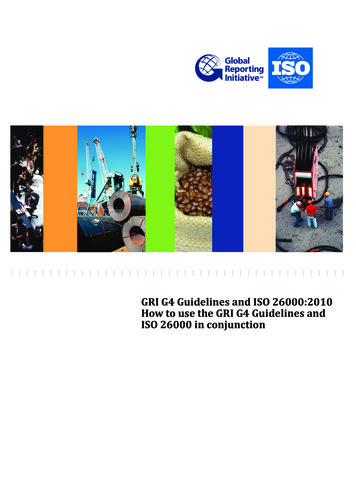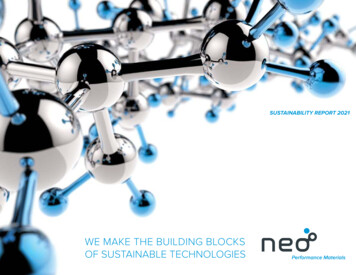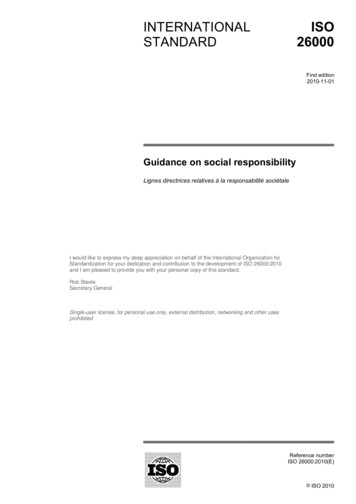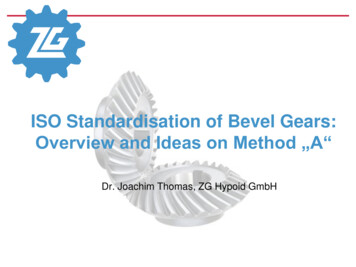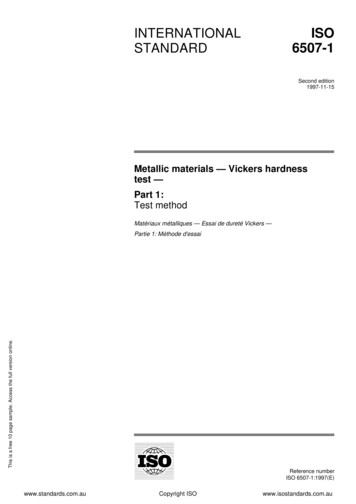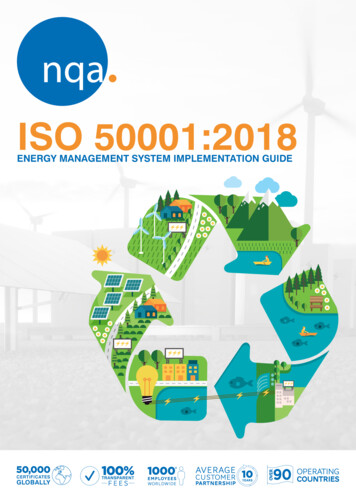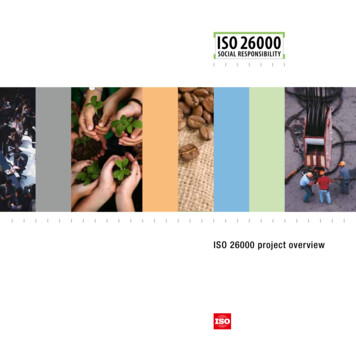
Transcription
ISO 26000 project overview
ISO – the International Organization for StandardizationISO has a membership of 163* national standards bodies from countries largeand small, industrialized, developing and in transition, in all regions of theworld. ISO’s portfolio of over 18 400* standards provides business, government and society with practical tools for all three dimensions of sustainabledevelopment: economic, environmental and social.ISO standards make a positive contribution to the world we live in. They facilitate trade, spread knowledge, disseminate innovative advances in technology,and share good management and conformity assessment practices.ISO standards provide solutions and achieve benefits for almost all sectors ofactivity, including agriculture, construction, mechanical engineering, manufacturing, distribution, transport, medical devices, information and communication technologies, the environment, energy, quality management, conformityassessment and services.ISO only develops standards for which there is a clear market requirement. Thework is carried out by experts in the subject drawn directly from the industrial,technical and business sectors that have identified the need for the standard,and which subsequently put the standard to use. These experts may be joinedby others with relevant knowledge, such as representatives of governmentagencies, testing laboratories, consumer associations and academia, and byinternational governmental and non-governmental organizations.An ISO International Standard represents a global consensus on the state ofthe art in the subject of that standard.* At the end of September 2010.2
ISO 26000projectoverviewISO 26000 project overviewThe International Standard ISO 26000, Guidance on social responsibility, provides harmonized, globally relevant guidance for private and public sectororganizations of all types based on international consensus among expert representatives of the main stakeholder groups, and so encourages the implementation of best practice in social responsibility worldwide.ISO 26000 both adds value to existing work on social responsibility (SR) andextends the understanding and implemention of SR by: Developing an international consensus on what SR means and the SRissues that organizations need to address Providing guidance on translating principles into effective actions Refining best practices that have already evolved and disseminating theinformation worldwide for the good of the international community.3
What is ISO 26000 ?ISO 26000 is an ISO International Standard giving guidance on SR. It is intendedfor use by organizations of all types, in both public and private sectors, in developed and developing countries, as well as in economies in transition. It will assistthem in their efforts to operate in the socially respon s ible manner that societyincreasingly demands.ISO 26000 contains voluntary guidance, not requirements, and therefore is notfor use as a certification standard like ISO 9001:2008 and ISO 14001:2004.Social responsibility : 7 core subjectsHolistic approach6.8*C om m u n it yin volvem en tan d d evelop m en tOrganizational6.2*6.7*C on su m erissu es6.3*Hu m an rig h t sO RGA N I Z AT I O N6.4*Lab ou rp ract icesgovernance6.6*Fair op erat in gp ract ices6.5*Th e en viron m en tInterdependence* The figures denote the corresponding clause numbers in ISO 26000.4
Why is ISO 26000 important ?Sustainable business for organizations means not only providing products andservices that satisfy the customer, and doing so without jeopardizing the environment, but also operating in a socially responsible manner.Pressure to do so comes from customers, consumers, governments, associa tionsand the public at large. At the same time, far-sighted organizational leaders recognize that lasting success must be built on credible business practices and the prevention of such activities as fraudulent accounting and labour exploitation.On the one hand, there has been a number of high-level declarations of principlerelated to SR and, on the other, there are many individual SR programmes andinitiatives. The challenge is how to put the prin c iples into practice and how toimplement SR effec tively and efficiently when even the understanding of what“social responsibility” means may vary from one programme to another. In addition, previous initiatives have tended to focus on “corporate social responsibility”, while ISO 26000 will provide SR guidance not only for business organiza-Photo : Richard Humantions, but also for public sector organizations of all types.ISO’s expertise is in developing harmonized inter national agreements based on double levels of consensus – among the principal categories of stakeholder, and amongcountries (ISO is a network of the national standards bodies of 163 coun tries).ISO 26000 distils a globally relevant understanding of what social responsibilityis and what organizations need to do to operate in a socially responsible way.5
How will ISO 26000 help organizations ?ISO 26000 will help all types of organization – regardless of their size, activityor location – to operate in a socially responsible manner by providing guidance on : Concepts, terms and definitions related to social responsibility Background, trends and characteristics of social responsibility Principles and practices relating to social responsibility Core subjects and issues of social responsibility Integrating, implementing and promoting socially responsible behaviourthroughout the organization and, through its policies and practices, withinits sphere of influence Identifying and engaging with stakeholders Communicating commitments, performance and other information relatedto social responsibility.6
What does ISO 26000 contain ?The content of ISO 26000 is structured as follows :ForewordIntroduction1 Scope2 Terms and definitions3 Understanding social responsibility4 Principles of social responsibility5 Recognizing social responsibility and engaging stakeholders6 Guidance on social responsibility core subjects7 Guidance on integrating social responsibility throughout an organizationAnnex A – Examples of voluntary initiatives and tools for social responsibilityAnnex B – Abbreviated termsBibliographyThe guidance provided in these sections is intended to be clear and understandable – even to non-specialists – as well as ob jective and applicable toall types of organization, including big business and small and medium-sizedenterprises, public administrations and governmental organizations.7
How does ISO 26000 relate to existing goodwork ?The guidance in ISO 26000 draws on best practice developed by existing public and private sector SR initiatives. It is consistent with and complements relevant declarations and conventions by the United Nations and its constituents,notably the International Labour Organization (ILO), with whom ISO has established a Memorandum of Un d erstanding (MoU) to ensure consistency with ILOlabour standards. ISO has also signed MoUs with the United Nations GlobalCompact Office (UNGCO) and with the Organisation for Economic Co-operationand Development (OECD) to enhance their cooperation on the development ofISO 26000.How did the ISO 26000 initiative come about ?The need for ISO to work on an SR standard was first identified in 2001 byISO/COPOLCO, Commit t ee on consumer policy. In 2003, the multi-stake h olderISO Ad Hoc Group on SR which had been set up by ISO’s Technical Management Board (TMB) completed an extensive overview of SR ini t iatives and issuesworldwide.In 2004, ISO held an international, multi-stakeholder conference on whetheror not it should launch SR work. The posi tive recommendation of this conference led to the establishment in late 2004 of the ISO Working Group on SocialResponsibility (ISO/WG SR) to develop the future ISO 26000 standard.8
What will ISO 26000 achieve ?ISO 26000 will integrate international exper t ise on social responsibility – whatit means, what issues an organization needs to address in order to operate ina socially responsible manner, and what is best practice in implementing SR.ISO 26000 will be a powerful SR tool to assist organizations to move from goodintentions to good actions.Who developed ISO 26000 ?The membership of the ISO/WG SR was the largest and the most broadly basedin terms of stakeholder representation of any single group formed to developan ISO standard.Six main stakeholder groups were represented : industry ; government ; labour ;consumers: nongovernmental organizations ; service, support, research andothers, as well as a geographical and gender-based balance of participants.Under the joint leadership of the ISO members for Brazil (ABNT) and Sweden(SIS), it was made up of experts from ISO members (national standards bodies – NSBs) and from liaison organizations (associations representing business, consumers or labour, or inter-governmental or nongovernmental organizations). Membership was limited to a maximum of six experts per NSB and twoexperts per liaison organization.In July 2010, the ISO/WG SR had 450 participating experts and 210 observersfrom 99 ISO member countries and 42 liaison organizations.9
Participating countriesThe ISO national members bodies (NSBs) of the following 83 countries (theacronyms of the NSBs appear in brackets) nominated experts to participate :10Argentina (IRAM)Denmark (DS)Kuwait (KOWSMD)Saudi Arabia (SASO)Armenia (SARM)Ecuador (INEN)Lebanon (LIBNOR)Serbia (ISS)Australia (SA)Egypt (EOS)Libya (LNCSM)Singapore (SPRING SG)Austria (ON)Fiji (FTSQCO)Luxembourg (ILNAS)South Africa (SABS)Bahrain (BSMD)Finland (SFS)Malaysia (DSM)Spain (AENOR)Bangladesh (BSTI)France (AFNOR)Mauritius (MSB)Sri Lanka (SLSI)Barbados (BNSI)Germany (DIN)Mexico (DGN)Sweden (SIS)Belarus (BELST)Ghana (GSB)Mongolia (MASM)Switzerland (SNV)Belgium (NBN)Greece (ELOT)Morocco (SNIMA)Syria (SASMO)Brazil (ABNT)India (BIS)Netherlands (NEN)Tanzania (TBS)Bulgaria (BDS)Indonesia (BSN)Nigeria (SON)Thailand (TISI)Canada (SCC)Iran (ISIRI)Norway (SN)Cameroon (CDNQ)Ireland (NSAI)Oman (DGSM )Trinidad andTobago (TTBS)Chile (INN)Israel (SII)Panama (COPANIT)Tunisia (INNORPI)China (SAC)Italy (UNI)Peru (INDECOPI)Turkey (TSE)Colombia (ICONTEC)Jamaica (JBS)Philippines (BPS)Ukraine (DSSU)Côte d lvoire (CODINORM)Japan (JISC)Poland (PKN)United ArabEmirates (ESMA)Croatia (HZN)Jordan (JISM)Czech Republic (CNI)Kazakhstan (KAZMEMST)Costa Rica (INTECO)Cuba (NC)Portugal (IPQ)Qatar (QS)United Kingdom (BSI)Uruguay (UNIT)Kenya (KEBS)Russian Federation(GOST R)USA (ANSI)Korea, Republic of (KATS)Saint Lucia (SLBS)Vietnam (TCVN).
Observer countriesThe ISO members of the 16 following countries (the acronyms of the NSBsappear in brackets) observed the work of the ISO/WG SR :Azerbaijan (AZSTAND)Estonia (EVS)Romania (ASRO)Bolivia (IBNORCA)Cyprus (CYS)HongKong, China (ITCHKSAR)Lithuania (LST)Latvia (LVS)New Zealand (SNZ)Malawi (MBS)Senegal (ASN)Palestine (PSI)Slovakia (SUTN)Zimbabwe (SAZ)Guatemala (COGUANOR)Uganda (UNBS).11
Liaison organizationsThe 42 following organizations had liaison status with the ISO/WG SR andnominated experts to participate in its work :AccountAbilityAICC (African Institute of CorporateCitizenship)AIHA (American Industrial HygieneAssociation)BIAC (The Business and IndustryAdvisory Committee to the OECD –Organisation for Economic Co-operation and Development)CI (Consumers International)EBEN (European Business EthicsNetwork)EC (European Commission)ICMM (International Council of Mining and Metals)IEPF (Institute for Energy and Environment of the French speakingcountries)IFAN (International Federation ofStandards Users)IIED (International Institute for Environmental and Development)IISD (International Institute for Sustainable Development)ILO (International Labour Organization)ECOLOGIA (Ecologists Linked forOrganizing Grassroots Initiatives andAction)INLAC (Latin-American Institute forQuality Assurance)EFQMInteramerican CSR NetworkEIRIS Foundation EIRIS (EthicalInvestment Research Services) Ltd.IOE (International Organization ofEmployers)FIABCI (International Real EstateFederation )IPIECA (International PetroleumIndustry Environmental ConservationAssociationForum Empresa/Ethos InstituteGRI (Global Reporting Initiative)ISEAL Alliance (International Socialand Environmental Accreditation andLabelling)IABC (International Association ofBusiness Communicators)ITUC (International Trade UnionConfederation)FLA (Fair Labor Association)12ICC (International Chamber ofCommerce)NORMAPME (European Officeof Crafts, Trades and Small andMedium-sized Enterprises forStandardisation)OECD (Organisation for EconomicCooperation and Development)OGP (International Association of Oiland Gas Producers)Red PuentesSAI (Social Accountability International)Transparency InternationalUNEP (United Nations EnvironmentProgramme)UNSD (United Nations Division forSustainable Development)UNCTAD (United Nations Conferenceon Trade and Development)UN Global CompactUNIDO (United Nations IndustrialDevelopment Organization)WBCSD (World Business Council onSustainable Development)WHO (World Health Organization)WSBI (World Savings BanksInstitute)/ ESBG (European SavingsBanks Group).
ISO internal liaisonsThe following ISO standards-developing technical committees (TCs) hadinternal liaison status with the ISO/WG SR :ISO/TC 159, ErgonomicsISO/TC 173, Assistive products for persons with disabilityISO/TC 176, Quality management and quality assurancePhoto : Stuart ForsterISO/TC 207, Environmental management.13
Resources ISO’s national member bodies, which are listed with full contact details onthe ISO Website at www.iso.org/isomembers The companion brochure, Discovering ISO 26000, which is availablefrom ISO national member bodies and from the ISO Central Secretariatsales@iso.org The ISO Website www.iso.org See the home page and click on the section“ Management and leadership standards ”. This brochure and DiscoveringISO 26000 can be accessed free of charge as HTML and PDF files on thissection at www.iso.org/sr ISO Focus magazine www.iso.org/isofocus 14
International Organizationfor StandardizationISO Central Secretariat1, chemin de la Voie-CreuseCase postale 56CH - 1211 Genève 20Switzerlandwww.iso.org ISO, 2010All rights reservedISBN 978-92-67-10537-6
ISO 26000 project overview The International Standard ISO 26000, Guidance on social responsibility, pro-vides harmonized, globally relevant guidance for private and public sector organizations of all types based on international consensus among expert rep-resentatives of the main stakeholder groups, and so encourages the imple-

